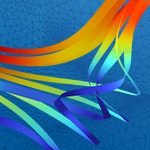See How Modeling and Simulation Is Used Across Industries
Multiphysics modeling and simulation drives innovation across industries and academia — as is evidenced by the many uses showcased in the technical papers and posters presented by engineers, researchers, and scientists at the COMSOL Conference each year.
Draw inspiration from the recent proceedings collected below, or, to find a specific presentation or filter by application area or conference year/location, use the Quick Search tool.
View the COMSOL Conference 2025 Collection
The ongoing trend towards miniaturization, higher integration as well as cost efficiency will make it necessary to investigate a new assembly method for micro components. In this paper, a novel method of fluidic-based micro assembly is presented. A self-assembly effect which is caused by ... Read More
Turbomachines blades are forced by a load resulting from the interaction with the fluid. The consequent vibrations, and the associated fatigue phenomena, can give catastrophic failures and the reduction of the blades life. It could be increased if damping system are used. The ... Read More
Vibration and Dynamic performances of the rotating machinery are conventionally evaluated based on the dominant structural forces such as the centrifugal forces. The increase in rotational speed, miniaturization and performance, demands for improved and accurate evaluation of the ... Read More
When acoustic applications include small geometries, i.e. mm/submillimeter range, so-called thermoviscous effects can greatly affect the pressure response. This paper deals with acoustic topology optimization of such miniature structures with thermoviscous effects taken into account. ... Read More
The spindle is regarded as the heart of the CNC machine tool. Typically, the spindle is operated using the belt or gear drives to realize the relative motion between workpiece and cutting tool. However, they cannot be operated at high speeds due to power transmission losses, thus ... Read More
COMSOL Multiphysics® with LiveLink™ for Matlab® is used for the numerical analysis of dielectric barrier discharges (DBD), which are widely used in various fields of plasma technology, such as surface processing, plasma medicine, and agriculture. The fluid model comprises balance ... Read More
Rich literature exists on calculation of copper loss in windings of high-frequency transformers and inductors. Most of the work was carried out in a Dowell approximation ignoring the windings aspect ratio and core presence. Calculation of losses at non-sinusoidal currents is made usually ... Read More
On one hand, the "float polishing" process consists of a tin lap having many concentric grooves, cut from a flat by single point diamond turning. This lap is rotated above a hydrostatic bearing spindle of high rigidity, damping and rotational accuracy. The optical surface thus floats ... Read More
The present work formulates the dynamics of a slender structure as a long beam. This results in a PDE that is fourth-order in space, and second order in time. In COMSOL the coupling method is used to decompose this problem into two second-order equations, one for displacements, and one ... Read More
An optimal control problem (OCP) is studied to a PDE of elliptic type as well as state constraints. The resulting optimality system contains two PDEs, one algebraic equation and the so called complementary slackness conditions, i.e. dual products between function spaces. At this point, ... Read More










